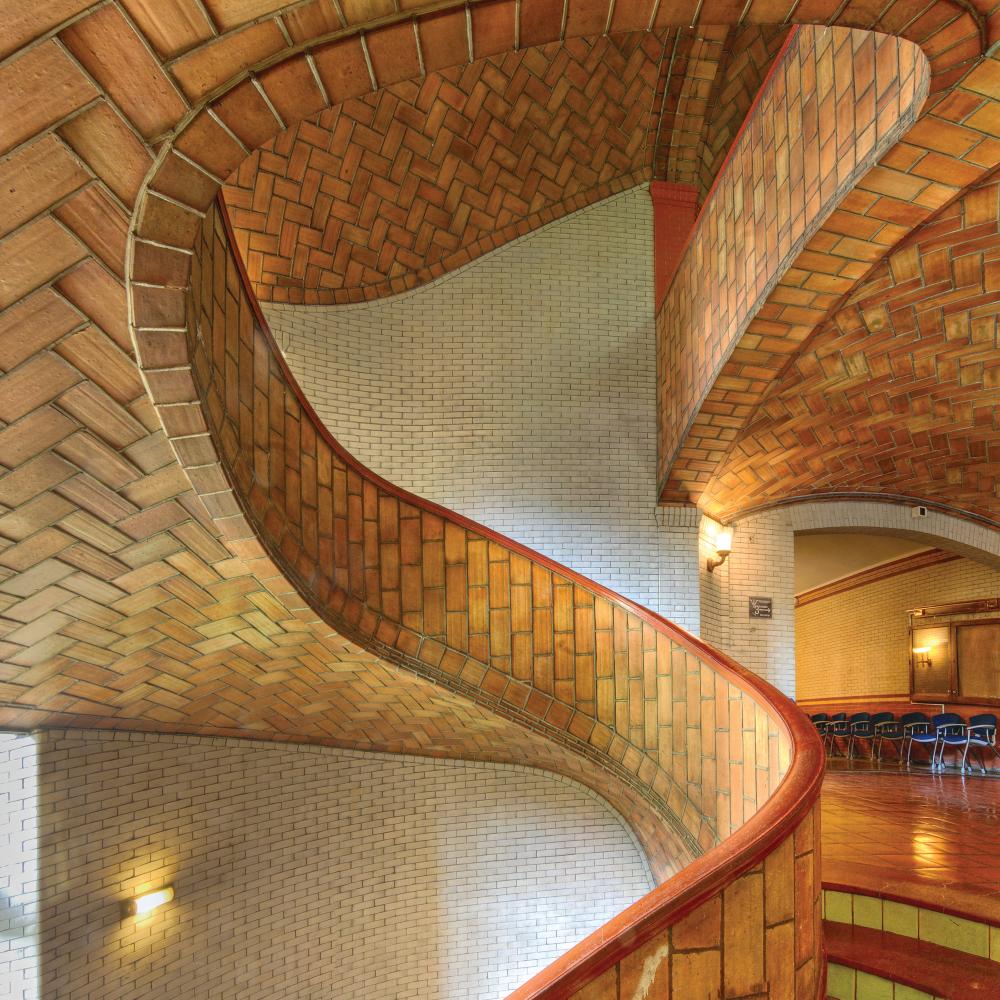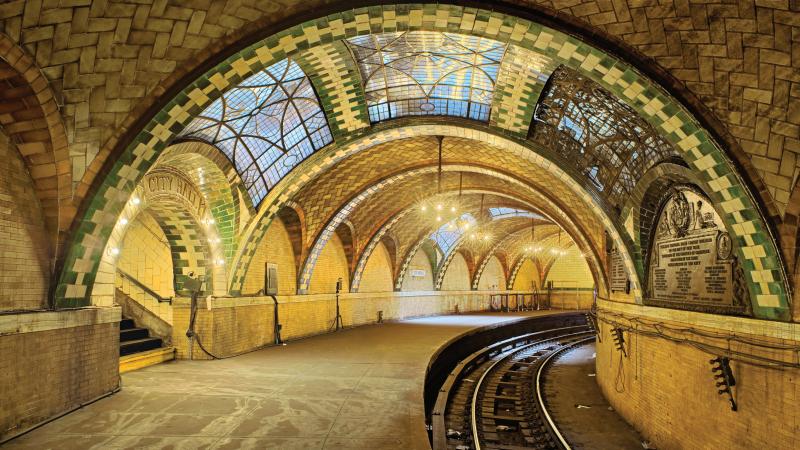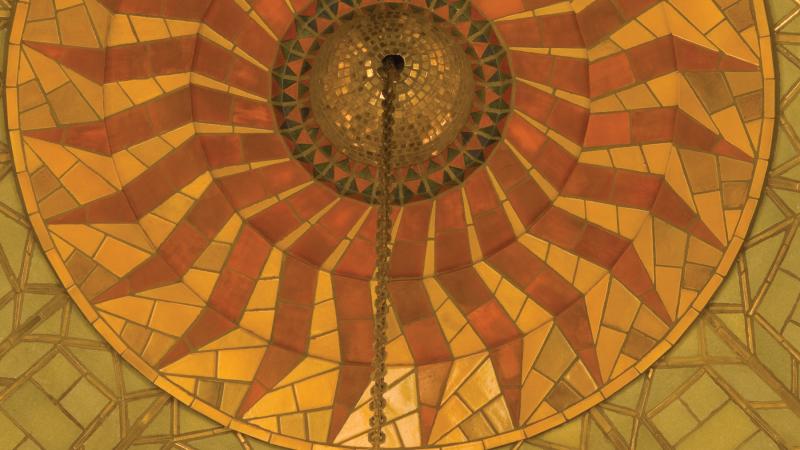In 1904, the first line of the New York City subway system opened, built by the Interborough Rapid Transit (IRT) Company. The line’s southernmost terminus was City Hall Station, an architectural showpiece intended to attract riders to the new subway. Three amethyst-glass skylights admitted sunshine from the street above. Brass chandeliers and artworks added to the appeal of the platform. And the vaulted ceiling was spectacular.
Designed and installed by a Spanish immigrant named Rafael Guastavino, it included a series of repeating arches along the tightly curving track decorated with colored tiles set in geometric patterns resembling inlaid wood. City Hall Station, later called an “underground cathedral” and the “Mona Lisa of subway stations,” ranked twelfth on Travel + Leisure magazine’s 2009 list of the world’s most beautiful subway stations.
Yet today, City Hall is a ghost station that the public has not seen for nearly seventy years. (Members of the New York Transit Museum can tour it on occasion.) As years passed, subway trains grew longer, posing problems for the tight curve of City Hall’s tracks, and the nearby Brooklyn Bridge station became a far busier venue. By 1945, only six hundred riders per day used City Hall Station; it closed that December 31.
Luckily, though, the public has many chances to see other examples of the magnificent vaulted ceilings created throughout the United States by that Spanish immigrant’s firm over a period of about half a century, beginning in 1889. The Guastavino Fireproof Construction Company installed ceilings in more than two hundred buildings in New York City alone, including the registry hall at Ellis Island, the main entrance to Carnegie Hall, the cavernous Cathedral of St. John the Divine in Morningside Heights, and the Oyster Bar in Grand Central Station, built in 1912, where unique acoustics allow someone to whisper in a corner and be heard sixty feet away as if speaking directly into another ’s ear. “The Guastavinos were some of the great master craftsmen, master builders, in the history of our country,” says MIT professor John Ochsendorf, a structural engineer and archaeologist who has researched their work for the past decade. “Yet, they are almost completely unsung. Their story has not been told and is not well known.”
That is about to change. An eye-opening exhibition funded by the National Endowment for the Humanities, “Palaces for the People: Guastavino and America’s Great Public Spaces,” opened in September at the Boston Public Library, the site of Guastavino’s first great triumph in America. Ochsendorf ’s team has been working with the library for seven years to create the presentation. Next year, it is scheduled to travel to the National Building Museum in Washington, D.C., and to the Museum of the City of New York .Ochsendorf’s sumptuous 2010 book, Guastavino Vaulting: The Art of Structural Tile, blends meticulous scholarship with lavish, coffee-table book layouts. And the MIT-based Guastavino Project (www.guastavino.net) is actively preserving and documenting the legacy of tile vaults that the company built in more than one thousand buildings in eleven countries, more than six hundred of which survive today.
The company kept records of their work, but they are incomplete, and don’t show all the projects with their vaults. Nonetheless,“the fact that we have records at all is something of a miracle,” says Ochsendorf. In the early 1960s, the art historian George Collins of Columbia was sitting in that university’s St. Paul’s Chapel. He noticed that the ceiling resembled ones in buildings by the Catalan architect Antoni Gaudí that he had been studying in Barcelona.
Collins learned that the vaulted ceiling was the work of the Guastavino company and called their factory in Woburn, Massachusetts. He asked if they had an inventory of their work. “Yes we do, but we’ve closed the company and have just put all the records in the Dumpster.” (Guastavino executed their last contract in 1962.) Collins said, “Don’t throw them away!” and drove to Woburn, where he loaded boxes of Guastavino drawings and records into his car. With NEH support, those materials have since been cataloged by the Avery Architectural and Fine Arts Library at Columbia University.
“Many of the artifacts [Collins] saved, including original drawings, will be in the exhibit,” Ochsendorf says.
The Guastavino saga is a father-son story. The patriarch, Rafael Guastavino, born in Valencia, Spain, in 1842, received a multifaceted education in construction at a school in Barcelona that conferred on him the title mestre d’obres (“master builder ”) in 1872. “It was something between an architect and an engineer,” Ochsendorf explains. By then Guastavino had already designed and built Barcelona’s largest textile factory. He was a highly accomplished craftsman when he came to New York City at thirty-nine years of age in 1881. “He knew there was a bigger market for him in the large cities of the United States,” says Ochsendorf. “And he wanted a better supply of modern building materials, like Portland cement, that were available in America.”
There were personal as well as professional reasons to start a new life. Guastavino’s marriage had fallen apart; his wife moved to Buenos Aires, taking three of their four children. “There was something scandalous about it,” Ochsendorf says. “I think he got involved with the nanny, and he arrived in New York with this very young nanny and his youngest son, Rafael Jr., who was nine years old.” Guastavino Sr. never saw his former wife nor any of his other children again, and never returned to Spain.
As a builder, the craftsman’s big break came in 1889 with the commission for work on the Boston Public Library (BPL). When it opened in 1895, the library became a showplace for his splendid vaulted ceilings. “We are not entirely clear as to how he got the project,” says Ochsendorf, “but we do know that they were very concerned about fire.” In the late nineteenth century there had been several huge fires in American cities. The great Chicago fire of 1871 burned more than seventeen thousand buildings. The next year, a fire in Boston burned seven hundred seventy buildings. “Fire was a constant concern for architects and builders,” says Ochsendorf, “and especially if you’re building a library—the BPL holds John Adams’s library and some of the earliest works of Shakespeare—these are important books, and you want the building to be fireproof.” Rafael Guastavino had advertised his tile vaulting system as a fireproof method of construction: It was, of course, based on thin bricks, not wood.
Yet there were social hurdles to overcome. The library’s lead designer was the celebrated architect Charles McKim of McKim, Mead, and White, a high-society firm. “That’s what was challenging for Guastavino—to crack into these circles,” Ochsendorf says. “He is an immigrant who doesn’t have good English and doesn’t have the social connections. But what he has is a product, and ability.” The skeptical McKim demanded that Guastavino build a trial vault and subject it to a load test. He did so, using piles of lead to subject his vault to massive pressures of up to five hundred fifty pounds per square foot. It proved safe.
Thus did this recent immigrant land an $85,554 contract for the library’s vaulted ceilings.Once he got his foot in the door, he made the building an absolute showcase for what he could do. Ochsendorf counted seven different types of vaulting there—a display that attracted the interest of the leading architects of the day. Furthermore, when Guastavino had built vaults in Spain, he had covered the bricks over with a plaster finish, so the tiles that composed the vaults were not visible. “But at the BPL, for the first time, he leaves the bricks exposed,” Ochsendorf says, “which opens up a new decorative possibility in American architecture.”
The Boston library proved the best advertisement Guastavino could have had, and conferred not only credibility, but, within his field, no small degree of renown. At the 1893 Columbian Exposition in Chicago, Guastavino was invited to give the keynote address to the Congress of the American Institute of Architects, allowing him to describe his ideas and techniques to the most concentrated gathering of potential clients one could imagine.
Business boomed. Guastavino vaults went up in thirty-two states, including heartland projects like the West Chamber of the State Capitol in Lincoln, Nebraska. The company eventually opened offices in eleven cities, and their brick factory in Woburn, Massachusetts, turned out nearly nine hundred thousand bricks per year, in varied shapes and sizes. The company’s peak year may have been 1910, when they were working on one hundred buildings up and down the East Coast. By then, Rafael Jr. was running the firm, having taken charge after his father ’s death in 1908. He had grown up in the business and took to it so readily that by age nineteen he had secured four U.S. patents.
“The magic of the Guastavino vaults was that in one system architects had everything they needed,” Ochsendorf explains. “It was a strong load-bearing system that was fireproof even at high temperatures, and was decorative as well—those tiles could produce beautiful interiors. The company was given complete freedom in design. Architects would write ‘Guastavino goes here’ in the plan, and leave that space empty.”
Rafael Jr.’s greatest triumph may have been his role in the construction of the Cathedral of St. John the Divine in New York, the largest church in North America (and fourth largest in the world), which is “Guastavino, top to bottom,” Ochsendorf says. Begun in 1892, the edifice has been under construction since then and remains unfinished even today. In the early 1900s, “they got the big crossing piers up but they didn’t know how to close the crossing where the nave intersects the transepts,” says Ochsendorf. “In the summer of 1909, Guastavino Jr. said, ‘I have a solution,’ and he built a dome over the crossing of the cathedral in fifteen weeks—one of the largest domes ever built in the world, and he built it with no support from below. Just like Brunelleschi’s dome in Florence, they built it in concentric rings that were self-supporting and stable at every stage of construction. Crowds gathered in the streets of New York to watch it. Scientific American wrote it up as a great achievement. That dome was meant as a temporary crossing—the Guastavino solution was the cheapest one they could find It’s now been there for over a century and still going strong. They spanned about 130 feet with a five-inch-thick dome, which, proportional to the radius, is far thinner than an eggshell.”
The firm needed teams of master craftsmen, and employed many Italian and English masons. They were working with fired-clay ceramic bricks that were very thin—typically six by twelve inches,and only about one inch thick. And without support from below, the masons would either standon a platform or work from above, as they did at St. John the Divine.
“If you’re going to build a Roman arch, you need to build formwork,” Ochsendorf explains, “or what is technically called centering, which is the heavy wooden frame that can support the weight of all the stone until the keystone is in place, because the arch won’t stand until the keystone has been set. But the Guastavino craftsmen could start at the four walls of a room and build toward the center. The masons could stand on a ladder or a platform, but they didn’t have to build a wooden frame to support their structure while it was being built—it almost seems miraculous. Their secret was using a thin brick and a very fast-setting mortar. They’d use plaster of Paris, put it on the edge of a brick, then hold it up where it needed to be for about five seconds, and the mortar would set enough so that it could support the weight of a single brick.”
Consider the great cathedrals of Europe, which have stood for a thousand years: They are filled with load-bearing vaults of brick or stone that happen to have magnificent decorative possibilities. The Guastavino creations “are similar to a Roman arch or a Gothic vault,” Ochsendorf says. “The bricks or stones are held in place by compression. Gravity is acting downwards, but the geometry of the structure channels the force of gravity down to the ground through the vault’s proportions and form. The Guastavinos were absolute masters at creating stable geometries.”
Rafael Sr. was part of a long line of Spanish master builders; he learned a method of construction that probably originated in fourteenth-century Spain with Moorish builders from North Africa. He was a nineteenth-century figure who based his craft on sound traditional knowledge. His son was more of a twentieth-century man, and developed calculation methods for planning the geometries of the vaults.
The cover of Guastavino Vaulting displays a spiral staircase built on the campus of Carnegie Mellon University. “It’s a complex spiral made from three layers of tile,” Ochsendorf says. “We have a difficult time today calculating the geometries of that structure. I have students here at MIT doing doctoral research, trying to understand how these structures stand up. We can’t build this staircase today.”
Thus, the Guastavino vaults may be an example of a lost art, like the Stradivarius violins of the seventeenth and eighteenth centuries. Some of their great buildings have literally been lost, like the original (1910) Pennsylvania Station in Manhattan, a McKim, Mead, and White building demolished in 1963 to make way for a new train station and Madison Square Garden. But their techniques and craft have also slipped away in the stream of time—though Ochsendorf, his students, and the Guastavino Project are trying to understand and recover them. “At a place like MIT, you could easily fall prey to the idea that we are at the pinnacle of all time—that we are at the height of technological achievement in the history of the world,” Ochsendorf says. “That’s probably true with respect to understanding the human brain. But there are also lost arts. They could do things that we are only beginning to understand and appreciate today.”
Using the research tool of learning by doing, Ochsendorf has been supervising four MIT students—Carmen Castaños, Suk Lee, Simon Okaine, and Nicholas Soane—who worked with masons to construct a half-scale reproduction of the very Guastavino vault in the BPL’s exhibition room where the “Palaces for the People” exhibit is currently on display. This reproduction, one element of the extensive presentation, is placed at waist height and is intentionally incomplete: an opening in the middle of the vault functions as an anatomical cross section, giving viewers a sense of how the craftsmen put these structures together. The exhibit also includes a documentary video showing the construction of the mock-up vault. “Making this reproduction has been a huge challenge for us!” Ochsendorf says. “Things that look effortless and simple are actually very difficult for us to do—even with our software and MIT degrees!”
Nonetheless, Ochsendorf, his students, and the Guastavino Project continue assembling the puzzle pieces to reconstruct this magnificent lost art and to build on the research that started in 2000 when Ochsendorf, then earning his doctorate at Cambridge University in England, won a Fulbright to study vaulting in Spain. Though his project is now more than a decade old, the data are still coming in. For example, Columbia University professor George Collins estimated that there were one hundred Guastavino buildings in the Boston area; the ongoing research has identified sixty-five of these, either extant or destroyed. The Guastavino Project encourages the public to tell them about vaulted ceilings they ’ve encountered that may have the Guastavino touch. “You’ll walk into a building and lift up a dropped ceiling and say, ‘Oh, there’s my old friend Guastavino,’” says Ochsendorf. “We discover one or two projects in an average month.”




